Access More Boat Tests
Already have an account? Login
Bertram 540 (2009-)
See Captain's Report
Brief Summary
This new boat has been designed to capture the hearts and minds of fishermen who -- while they would like giant tuna carcasses strapped aboard and black marlin trophy mounts -- aspire to something more than a big boat that is an easily cleaned washbasin for fish blood and guts. The Ferretti group is building a boat for the more sophisticated sportsman, a man who is looking for more than just good fishability in a convertible and also wants a luxurious cruising boat and a classy entertainment venue. Enter the all new Bertram 540.
Specifications
| Length Overall | 54' 2'' / 16.5 m |
|---|---|
| Beam |
17' 10'' 5.43 m |
| Dry Weight |
83,737 lbs. 38.0 ton |
| Draft |
5' 5'' 1.65 m |
| Deadrise/Transom | N/A |
| Max Headroom | N/A |
| Bridge Clearance | N/A |
| Fuel Capacity |
1,524 gal. 5,769 L |
| Water Capacity |
225 gal. 850 L |
Engine Options
| Tested Engine |
See Captain's Report |
|---|---|
| Std. Power |
2 x 1224-hp MAN V-12 |
| Opt. Power |
2 x 1360-hp MAN V-12 2 X 1676-hp CAT C-32 |
Captain's Report
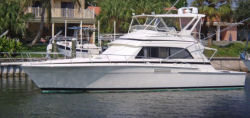
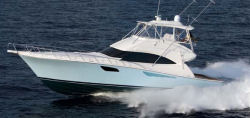
The new Bertram 540 (r) is clearly more sleek, modern, less boxy and clunky than the old 1981 Bertram 54 design.
Report by Capt. Steve Larivee--
My first look at the Bertram 540 showed a boat with sleek lines and curves in all the right places. I gave myself a moment to compare this new boat with my mental snapshot of the vintage 54, almost creating a side by side comparison. The first thing that jumped out at me was the forward windows. I had to do a double take to see that they weren’t just painted on for looks, but sure enough, they were real. Already, I’m seeing the “outside the box” thinking of the new Bertram 540. Forward windows, generally, haven’t been seen on Bertram convertibles since about 1983. The old Bertram started life in 1981 with forward facing windows, but then a couple of years later the company glassed them over for the rest of the boat’s 20-year life. (Hatteras got rid of its glass windshields in 1986 on its 55 convertible.)
Hints of Rybovich
Then I let my eyes wander to her bow. The new Bertram has an ever-so-slight concave curve to the stem, while the old Bertram was ruler-straight. My eye then followed the sheer line aft and there I found a graceful swoop down to the cockpit coaming that reminded me more of a late Rybovich design or a Dave Martin sweep than the old Bertram which had an angular, ruler-straight drop in the sheer. The rounded aft part of the side windows is all Rybovich, not squared-off like the Bertram 54.
Myth Makers
The new Bertram 54 is nearly a foot beamier than the old and some of these inches went into wider side decks than the old 54 had. Of course that is a good thing, but that’s not the half of it. It’s hard to believe these days, but that “great old” Bertram 54 actually had engine air vents on the side decks (you had to step over them to get to the bow) in addition to a rather ugly rectangular engine air box on the hull sides, for the first five years it was built! Hard to believe, but true. Evidently this little problem wasn’t too embarrassing to the folks at Bertram because it wasn’t rectified until the late ‘80s.
The more I compared the two boats, the “Legendary 54” and the new 540, the more I was beginning to think that perhaps some “myth” had crept into the old legend.
The Cockpit
The cockpit had no surprises, and I didn’t expect any. There really aren’t any tricks to cockpits, they all fish the same: they all have rod holders, transom doors, fish boxes, live bait wells and the now standard mezzanine seating with freezers and refer below. There is room to mount a fighting chair, and room behind it for the mate to steer it while the angler is hooked-up and fighting.
Back in the old days anglers and crew would perch themselves on top of the freezer chest up against the cabin bulkhead while trolling, waiting for fish to strike. As a result owners had to add the canvas awning you will find on most vintage Bertrams. The new 540 has a nice flying bridge overhang that provided shade for those sitting on the mezzanine. Again John Rybovich had figured this out a long time ago and it is pretty clear to me that Bertram’s designers, Gianni and Paola Zuccon, had done their homework before they set down at the CAD-CAM.
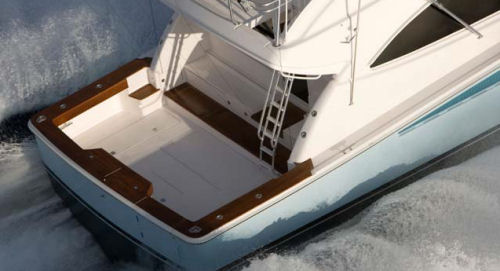
Thanks to her 17'10" beam – nearly a foot greater than the old 54 -- there's 178 sq ft of cockpit area. Note the powder coated finish on the ladder and grab rails.
The Innovative Salon
When you walk into the main salon, you can’t help but notice that this is a very different arrangement. This is not your typical sportfish, and you have to do a double take at the cockpit to be sure that you are actually on a boat made for extreme fishing. First, it’s those windows. I stood inside the doorway, leaning against the counter next to me, and just took in the natural light of what appeared to be a very large and open main salon. And I actually had a view ahead. The salon seemed larger than any I had been on before in this size range. I found myself liking the airy, bright interior. Perhaps the Italians know what they are doing, after all.
In the late 1970s and early ‘80s owners used to simply cover up those forward windows with blinds, curtains or masks on the outside of the windshields to stop the sun from tuning the interiors into an oven. Eventually builders simply took that to the next obvious step and did away with troublesome windshields (they often leaked or cracked and were somewhat vulnerable to serious green water). It was also a lot cheaper to just glass over this area. Inside they installed cabinets and a place for a TV screen. And so it has been for the last 25 years or so on every major sportfishing boat or convertible – until now.
In the Bertram 540, two 16,000 BTU air conditioners are able to keep the temperature at bay. And gone are the individual vents that blow cold air onto a few unlucky guests. Looking up, there are open areas in the length of the overhead that disperse the cooled air evenly across the whole room. Great idea and I don’t know why everyone doesn’t do this. Add 10 “Thank You” points to the Bertram 540 for this.
The Aft Galley
Now with the cooling taken care of, I pondered the lost storage space those forward cabinets used to accommodate. It mostly gave you cabinet space for the galley...so where did that space get moved to? Then it struck me. There’s no longer a galley up forward. That counter I was leaning on was actually a galley counter, in the aft end of the salon. Then, as I pictured myself working and cruising in this boat, the advantages started to hit me in waves.
Firstly, it made the forward windows so much more allowable. This opened up and brightened what was once typically a dark cave of a salon. Secondly, it allowed for whoever has galley duty to remain a part of the action by staying near the cockpit, inarguably the work center of any fishing machine. Simply put, gone are the days of “Oh man, you won’t believe what you just missed!!!” simply because you wanted to make a sandwich. Brilliant!
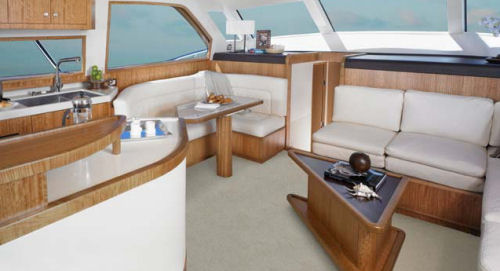
By adding forward windows and moving the galley aft, this Bertram has a main salon that is bright and airy. Check out the grab rail attached to the 6’6” high overhead. The couch to port can be removed in favor of an optional lower helm.
Bertram even took the galley aft concept a bit further towards keeping the “galley slave” a part of the cockpit action, by adding a retractable window in the aft bulkhead, so you aren’t just watching the action, you’re an integral part of it. Lower the window to hand out food, or just keep it open in temperate climes.
The galley is functional, featuring two large refrigerated drawers, and four freezer drawers. And there’s plenty of room to stand behind them when pulled out to the full open position. The stove is recessed into the counter to port and it has the standard removable cover to add counter space when not cooking. I’ve always complained that these should be hinged, since there’s never any place to put those covers when you do want to cook. Bertram however, added a dedicated space for it right under the retractable window. Add another 10 “Thank You” points for that move.
A Lower Helm Option
One last benefit to the “galley aft” arrangement. By giving the boat the benefit of having forward windows, you also have the advantage of an optional lower helm station. The 540 accommodates it to the port forward section of the salon at the cost of removing the settee. Some cruising families will love that feature when the weather turns foul. I tested hull #1 which did not have this option, but I have to believe that visibility would be fine in the salon. The bow only raised 5 degrees at cruise, so steering from the salon is certainly a viable option.
For myself, I think the isinglass Bertram installed under the flying bridge hardtop is more than adequate to keep the helmsman dry and snug in all but the coldest situations.
Some Suggestions
While I became a quick fan of the “galley aft” concept, there are, however, two things that I see as needing improvement with the galley layout itself. First, the switch for retracting the aft window is outside the galley, just inside the salon door in fact, which means you have to go all the way around the counter to get to it. Why not move it into the galley where it belongs? Secondly, there is an elevated counter on top of the main galley counter. It serves no real purpose (that I’m aware of), so I would get rid of it and then add 2-3 deck mounted stools to turn that counter into an additional eating area for those quick snacks, while still leaving fast access to the cockpit.
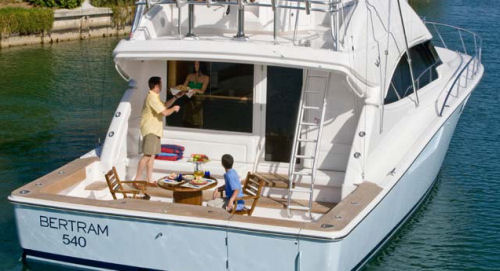
Moving the galley aft means you never miss out on what’s going on in the cockpit. Adding a retractable window to the aft bulkhead means you’re a part of it as well. I like the teak helm and companion seating on the flybridge and there’s a molded in footrest for the captain. Note the large transom door. This is a cockpit made for entertaining, cocktail parties or al fresco dining.
Accommodations Layout
Given the surprises and innovations in the main salon, I was a bit disappointed that they didn’t keep coming once I got down below. But the accommodations were still very comfortable and allowed for just the right touch of luxury that Bertram was striving for. Immediately to port are the two guest berths laid out in an “L” pattern. This is how all bunks should be, it allows for sitting without hitting your head. Just ahead of that cabin was a door that opened to the over-under washer/dryer. To starboard, is the master stateroom. It features a queen sized island berth and an en suite head. The master also featured a large built-in window that was duplicated in the guest cabin opposite, only I didn’t give it its due notice there. Here it’s such a large part of the décor that you can’t help but notice that it’s not just another small port light. It’s actually multiple panes of thick glass that are molded into the hull and in fact, add to its integrity. So much for no surprises!
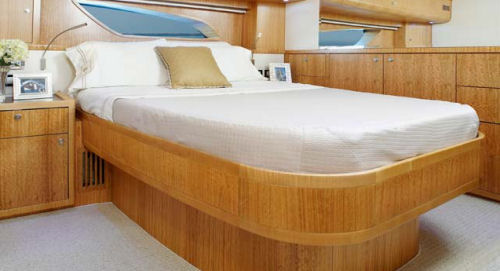
The master stateroom features a queen sized island berth and large windows that are molded into the hull.
The forward VIP stateroom is pretty standard with a pedestal queen pretty much like every other convertible this size being built today. However, most builders these days will install two separate berths here, one to port and one to starboard which gives the cabin added versatility and opens it up a bit. I’m sure Bertram would be glad to do the same.
What Have the Cool Captains Done?
Many convertibles used to have portlights in the master staterooms, but as the “clean look” gathered momentum, and Bertram may have been among the first to start the trend back in the early ‘80s, by the mid-1990s, portlights were out virtually everywhere on these battlewagons. Certainly professional captains of these convertibles in the 1990s were champions of the “cool, clean smooth” look. First, tenders and davits on the bow disappeared because these were specialized fishing machines not cruising boats. Then, it wasn’t long until bow rails and life lines were stripped off by the cool captains (against ABYC regs).
Since it is just a tournament fishing machine and not used for cruising, one didn’t need to anchor, so get those ugly things out of the way along with the windlass and huge anchor cleats. With just a couple of small recessed cleats for dock lines and a couple of recessed deck hatches, the fore deck was clean as a whistle.
What Does “Convertible” Mean, Anyhow?
We like the fact that Bertram has a mind of its own and has designed back into the boat something that should never have been taken out in the first place. The Italian Ferretti folks running the American Bertram know what the English word “convertible” means! It doesn’t mean flat-out fishing machine! If you want that, get a “Sportfisherman” like a Merritt, something from Harker’s Island, or Bernie Madoff’s old Rybovich – we hear it’s for sale.
The folks at Bertram and the Ferretti Group have quite intentionally designed a boat for cruising, entertaining and fishing. They have done that because they have noticed that for the last 6 years or so the hard-core fishing tournament crowd is getting smaller. Killing billfish is a thing of the past and the baby boomers are giving way to a new generation who look at the world, at fishing, and at boating differently. They have noticed that there has been a steady decline in sportfish boat sales but cruising boats are as popular as ever (the current economy not withstanding). Thus the “Convertible” -- which was intended as a boat that could do both activities well – is as viable a concept today as ever.
I think that it is ironic that it took Bertram to re-introduce the convertible.
Superior Flying Bridge
Moving up to the flybridge, I was happy to see that the ladder had a decent enough angle so that you didn’t feel like you were scaling a vertical wall. This goes a long way towards keeping those folks that have not acquired their sea legs more comfortable. Both it, and all the grab rails, had a white powder coated finish that was very easy on the eyes, to say nothing of making maintenance easier. Once on the bridge, there’s a commanding view with isinglass all around.
It’s also here that, in my opinion, the Bertram 540 has again scored over her nearest competitors by giving the bridge deck the best possible layout. The helm console is far enough aft that the captain can see, and respond to, the action in the cockpit clearly and easily – yet still see the bow. The helm station is also aligned with the centerline of the boat, just the way I like it, so that the helmsman with a bit of practice instinctively knows how much room is between his shinny white topsides and those nasty creosote pilings in a tight slip.
Forward of the console is a great U-shaped seating arrangement that will make a perfect gathering spot while heading out to the fishing grounds, and a great bragging spot on the way back. This spot begs for a pedestal mounted table. A quick check of the options list and sure enough, there it was. Bertram knows that during a party, people love to gather on the flying bridge, and there is plenty of room, plus counter space for food and wine. Of course icemakers and refers are installed here.
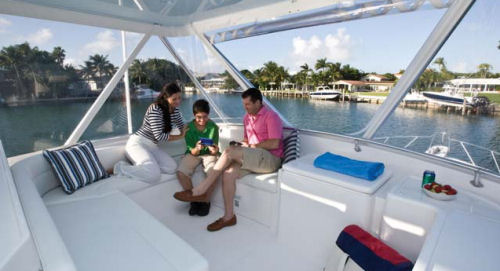
Just ahead of the helm is a great gathering spot. We'd add the optional pedestal table.
The Helm
Back at the helm, there are two things I would change. First, there needs to be a recessed area to put stuff. Someplace to lay your cell phone, portable GPS or whatever, without having it go sliding to the deck. Secondly, I’m not a big fan of the layout of the electrical switches. They just seemed to be all jumbled together helter-skelter. They are over to port in front of the companion seat and under a hinged plastic cover. To operate them the skipper has to leave the helm, lift the cover, then search for the right switch since they are in no logical order. I’d separate them into groups for engine, navigation, courtesy, etc. I’d color the horn switch red and move it to an obvious spot handy to the helmsman. Problem solved.
Underway
So much for the tour, now let’s get this puppy underway! When Bertram tasked its design engineers with revamping the coveted 54, several were concerned about touching what was already a premier riding hull, and I was among them. Don’t fix it if it ain’t broke! Truth be told, while the deep-V hull design rode well, it was also a bit rolly at anchor or when trolling. As we have already seen, there was room for improvement in this venerable old design, which should not be surprising since the design was three decades old. The changes were subtle enough, adding a warped deadrise to the stern to give increased performance through a varied envelope, as well as the inclusion of a modified tunnel over the props. These two changes gave the boat both increased performance but also a lower draft than otherwise. 12” hard chines were added to give the boat more stability at rest and when trolling, as well as some added flat running surface to improve speed and knock down spray.
The 540 has a displacement of around 83,737 lbs. fully loaded and wet, a beam of 17’10” and a 5’5” draft. On test day winds were 5-10 out of the north. The old Bertram 54 was known for its rough water capability and so we took her down the long, winding Miami River, then straight out Government Cut to find the squarest and hardest waves possible in the indigo-blue water of the Gulf Stream. 20 miles out the 15-mph northerly started pushing up the five-knot Stream a bit so were able to finds some 2’ to 4’ lumps. Occasionally we saw a breaking sea.
Our test boat was powered with the optional twin CAT C-32 ACERTs producing 1,676-hp each. The standard engines are twin MAN V-12’s at 1,224-hp, and upgrading to the Cats adds a penalty of only 3,422 lbs. so it’s easy to see why virtually all of the current orders are with the Cat engines. (There is also a middle ground option for MAN V-12’s at 1,360-hp.) Both the MAN choices are counter rotating, the Cats are not. They had ZF 2060A transmissions hanging off the back end with a reduction ratio of 2:029/1A and were turning Veem 34x51 5-bladed props.
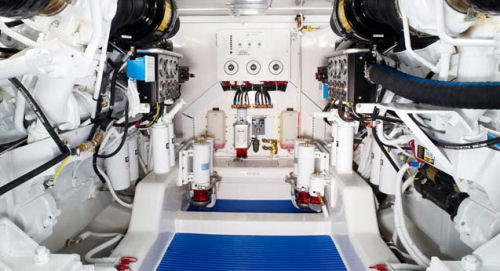
A clean, gel-coated engine room. There's 5'4" of headroom and the air intake vents are filtered to keep saltwater and moisture away from the machinery. Everything is labeled clearly and note the oil change quick connects (with the red caps) at the bottom of the photo. Same accommodations for waste oil. And there’s plenty of room to get around all sides.
She draws fuel from a single centerline mounted tank that straddles the center of gravity, so burning fuel will have no adverse effects on stability. Add 10 more “thank you” points.
Performance in a Seaway
We started our test runs into the seas and with the tide. Her sharp entry carved through the waves cleanly, with that flared bow throwing water far away from the hull. She felt solid.
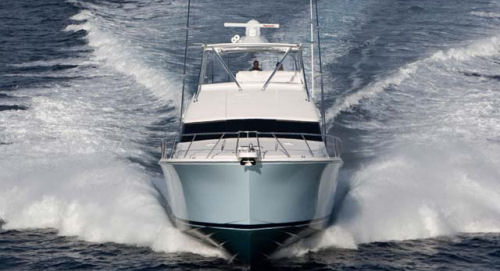
With a sharp entry and flared bow, she handled the seas like a thoroughbred.
It felt as if she wanted us to throw more at her, but alas, we had both hammers all the way down pouring 3 gallons a minute into the 3,350 horses and she just shrugged it off. The hull didn’t slap, bang or shudder. There was just a little pounding – as there should have been – as we chomped into the four footers. Although I brought my sea legs onboard with me, neither I nor the landlubber cameraman that accompanied me, felt that we had to hang on for dear life. Quite the contrary, we were able to move about the flybridge with the usual hand on the grabrails, rather than having to clutch, pick your moment to grab the next, and then continue as needed. It was surprisingly comfortable, and this was to be the worst of it.
Turning to a beam sea and she rode cleanly and smoothly through them with hardly any roll. Turning downwind and she tracked straight and true. No wandering from the following seas pushing the stern about and she was surprisingly stable.
The Turning Test
The rudder deflects 22 degrees for good low speed maneuverability, but at cruise, you’ll get roughly half that before the force of the prop wash against the rudder adds enough resistance to stop you from forcing it further. So in other words, when cruising, your turns will have a wide radius unless you slow down, to allow for turning the wheel further.
The Backing Down Test
When there’s a fish on you’ll naturally need to back down hard. Something no boat is keen to do, as the sharp entry is at the other end. I did it with the 540 and she had great directional control on the engines, literally going wherever I wanted her to, in spite of the 2’-4’ seas – and doing it quickly. Backing hard directly into the seas, she did what any boat would do and shipped water right over the transom. I pushed her hard to ensure she would do exactly that, mostly to judge how quickly she could discharge that water. True to Bertram’s reputation, she shed whatever we could force into the cockpit right back where it came from quickly. This boat was made to fight the fight.
Low-Speed Handling
With no bow thrusters or joysticks you’re reminded that this isn’t an entry level yacht. However, there was plenty of torque in those 5 bladed props so low speed maneuvering is hardly a problem. There is a 2 second delay in the transmission, so ease it into gear and hold before advancing the throttle, otherwise you’ll be rewarded with a hard clunk into gear. As soon as the transmission’s engaged, though, she moves ahead with authority, so be prepared to pull it out of gear in close quarters. You’ll hear a welcome “chirp” to let you know you’ve hit neutral.
There’s a trolling feature on the options list and it’s a good idea to consider it. It will allow you to slow your idle speed considerably. Without it she idles at a brisk 10.5 MPH. The boat won’t walk sideways in the conventional manner, due to her torque, but you can put the wheel hard over and use your single outboard (that is to say the engine on the outside of the turn radius) engine going back and forth from forward to reverse to push her sideways in the direction you want to go and she’ll head there smoothly.
Best Cruise Speed and Range
Believe it or not, some people who buy these boats care only about how fast the boat will go when racing their buddies out to the fishing grounds in the morning and back to the docks at night for a frosty one. All of the boat builders tell us that if a boat in this class won’t do 40 knots they have a problem. Even in this day and age? Yup, that’s what we are told.
To get that kind of speed one needs to test in flat water, such as in Biscayne Bay. Since we have never heard of anglers going there to catch big game, we didn’t go there to find out what the Bertram 540’s top speed could be. It is really not very important because what really counts is a boat’s “best cruise” speed and mile per gallon performance and the boat’s range. And these numbers we got in the Gulf Stream where a boat like this will really be operating.
In the sea conditions we encountered, the boat’s sweet spot for best cruise is from 1300 to 1700 rpm where is traveled from 17.8 knots to 29 knots during our runs. In that range the boat gets .33 nautical miles per gallon throughout the range, burning from 69.7 to 88 gph. The absolute best cruise setting appears to be at 1700 rpm, where the boat goes 29 knots and has a range of 454 nautical miles.
For owners who want to take the boat to Costa Rica or Peru, the boat has the range if you don’t mind going at near-displacement speeds. For example, at 11.2 knots which is the speed most large motoryachts travel on long cruises, the boat’s range is 787 nm on 90% of the boat’s 1,534 fuel capacity, which is the greatest of any boat in class. Dial the speed back to 9.1 knots and she’ll go 1,294 miles on a load of fuel.
If you’re curious about the boat’s absolute top speed in flat water, just ask the folks at Bertram to give you a test run in Biscayne Bay, and we’re sure they’ll be happy to oblige.
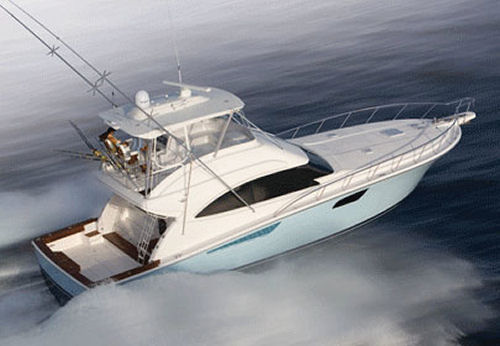 Conclusion
Conclusion
If anyone shared my attitude regarding Bertram messing with an already proven success story like the 54, this test should put those feelings to rest. Bertram set its sights on improving on the old 54 and they did it with flying colors. While no boat is perfect, my only criticisms were the switch placement at the helm and the retractable window switch placement in the galley. The two big design departures of the 540 – the windshields in the salon and the aft galley – in my opinion work just fine.
But more importantly, the changes to the interior will go far towards driving sales to not only the hard-core extreme fishermen that this boat was originally built for, but also to more casual fishermen who are looking a serious cruising platform and yes, the black tie affair.
Perhaps a new legend has been born.
